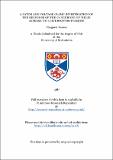A patch and voltage clamp investigation of the response of the C1 neurone of 'Helix aspersa' to 5-hydroxytryptamine
Abstract
Application of 5-hydroxytryptamine induces a voltage-dependent inward current in voltage clamped C1 neurones of Helix aspersa. This response has been shown to be the result of a decrease in K conductance and was studied using patch clamp and voltage clamp techniques. Single channel K currents were recorded from cell-attached patches of the C1 neurone. Two sizes of unitary outward currents were commonly observed. The I-V relationships of both these unitary currents could be fitted by the Goldman-Hodgkin-Katz equation for a K current, having slope conductances of around 14pS and 54pS at +10mV, patch potential. Experiments, altering the K concentration in the patch pipette, or on the outer surface of isolated outside-out patches, suggested that these unitary currents were due to the flow of K+ ions. Application of 5-hydroxytryptamine onto the C1 neurone, from out with the patch pipette, reduced the activity of the larger K channels, recorded in the cell-attached patch. Both Ca-dependent, and Ca-independent K channels were observed on isolated inside-out membrane patches. It was unclear which of these types of channel corresponded to the 5-hydroxytryptamine sensitive channel in the cell-attached patch. Voltage clamp experiments also gave confusing results regarding the Ca-dependency of the 5-hydroxytryptamine response. However, in some C1 neurones 5-hydroxytryptamine caused a flattening of the "N" shaped I-V relationship, suggesting a decrease in the Ca-dependent outward current. The possibility that more than one type of K current was suppressed by 5-hydroxytryptamine was considered. The effect of phosphodiesterase inhibitors was consistent with a mediation of the 5-hydroxytryptamine response by cyclic nucleotides. Injection of cAMP induced an inward current in the C1 neurone. Single channel outward currents, which reversed at -50mV, were recorded from the A neurone. The activity of these channels was increased by 5-hydroxytryptamine, but their ionic nature was uncertain. Unitary outward currents of the M neurone were also recorded.
Type
Thesis, PhD Doctor of Philosophy
Collections
Items in the St Andrews Research Repository are protected by copyright, with all rights reserved, unless otherwise indicated.

